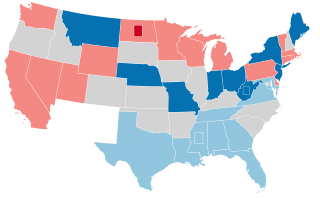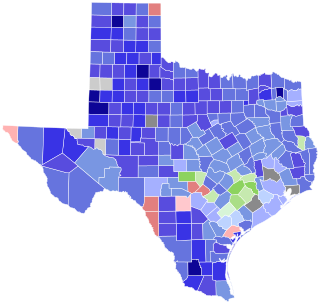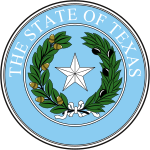
The 1952 United States Senate elections was an election for the United States Senate which coincided with the election of Dwight D. Eisenhower to the presidency by a large margin. The 32 Senate seats of Class 1 were contested in regular elections, and three special elections were held to fill vacancies. The Republicans took control of the Senate by managing to make a net gain of two seats. However, Wayne Morse (R-OR) became an independent forcing Republicans to rely on Vice President Richard Nixon's tie-breaking vote, although Republicans maintained a 48–47–1 plurality. Wayne Morse would caucus with the Republicans at the start of Congress’ second session on January 6, 1954 to allow the GOP to remain in control of the Senate. This was the third time, as well as second consecutive, in which a sitting Senate leader lost his seat.

Oscar Branch Colquitt was an American politician who served as the 25th governor of Texas from January 17, 1911, to January 19, 1915. He was a member of the Democratic Party. Colquitt defended the actions of the Texas Rangers who allegedly crossed into Mexico in pursuit of the body of Clemente Vergara in March 1914.

The 2006 Texas gubernatorial election was held on November 7, 2006, to elect the governor of Texas. The election was a rare five-way race, with incumbent Republican governor Rick Perry running for re-election against Democrat Chris Bell and Independents Carole Keeton Strayhorn and Kinky Friedman, as well as Libertarian nominee James Werner.

The 1910–11 United States Senate election were held on various dates in various states. As these U.S. Senate elections were prior to the ratification of the Seventeenth Amendment in 1913, senators were primarily chosen by state legislatures. Senators were elected over a wide range of time throughout 1910 and 1911, and a seat may have been filled months late or remained vacant due to legislative deadlock. However, some states had already begun direct elections during this time. Oregon pioneered direct election and experimented with different measures over several years until it succeeded in 1907. Soon after, Nebraska followed suit and laid the foundation for other states to adopt measures reflecting the people's will. By 1912, as many as 29 states elected senators either as nominees of their party's primary or in conjunction with a general election.

The 1942 United States Senate election in Texas was held on November 3, 1942. Incumbent Democratic U.S. Senator W. Lee "Pappy" O'Daniel was re-elected to a second term.

The 1916 United States Senate election in Texas was held on November 7, 1916. Incumbent Democratic U.S. Senator Charles Culberson was re-elected to a fourth term in office. Culberson survived a challenge from former Governor Oscar Colquitt in the Democratic primary, then easily won the general election. He was challenged by Republican Alex W. Atcheson and Socialist Thomas Hickey, publisher of The Rebel.

The 1928 United States Senate election in Texas was held on November 6, 1928. Incumbent Democratic U.S. Senator Earle Mayfield ran for re-election to a second term.
Democrat William Proxmire won a special election to fill the vacancy created by the death of Senator Joseph R. McCarthy (R-WI). Also, Price Daniel (D-TX) left the Senate to become governor of Texas, and Democrat Ralph Yarborough won a special election for that Senate seat. The Democrats thus made a net gain of one seat. However, Congress was out of session at the time of the Democratic gain in Wisconsin, and the Republicans gained a Democratic-held seat only weeks after the next session started, when Republican John D. Hoblitzell Jr. was appointed to fill the vacancy created by the death of Senator Matthew M. Neely (D-WV).
There were three special elections to the United States Senate in 1941 during the 77th United States Congress.

The 1948 Texas gubernatorial election was held on November 2, 1948.

The 1936 Texas gubernatorial election was held on November 3, 1936.

The 1906 Texas gubernatorial election was held to elect the Governor of Texas. Thomas Mitchell Campbell was elected to a two-year term in office.

The 1934 Texas gubernatorial election was held on 6 November 1934 in order to elect the Governor of Texas. Democratic nominee and incumbent Attorney General of Texas James Burr V Allred defeated Republican nominee D. E. Waggoner in a landslide.

The 1930 Texas gubernatorial election was held on 4 November 1930 in order to elect the Governor of Texas. Democratic nominee Ross S. Sterling defeated Republican nominee William E. Talbot.

The 1922 Texas gubernatorial election was held on 7 November 1922 in order to elect the Governor of Texas. Incumbent Democratic Governor Pat Morris Neff won re-election to a second term, defeating Republican candidate William Hawley Atwell in a landslide.

The 1920 Texas gubernatorial election was held on 2 November 1920 in order to elect the Governor of Texas. Former Democratic state representative Pat Morris Neff won comfortably in a four-way race against Republican nominee J. G. Culbertson, American Party of Texas nominee T. H. McGregor, and Black and Tan Republican nominee Hickerson Capers.

The 1918 Texas gubernatorial election was held on November 5, 1918, in order to elect the Governor of Texas. Incumbent Democratic governor William Pettus Hobby easily won re-election to his first full term after ascending to the governorship in 1917 upon the impeachment and conviction of his predecessor, governor James "Pa" Ferguson. He defeated Republican nominee Charles Albert Boynton.

The 1916 Texas gubernatorial election was held on November 7, 1916, in order to elect the Governor of Texas. Incumbent Democratic governor James E. "Pa" Ferguson easily won re-election to a second term, defeating his Republican challenger, Rentfro Creager.

The 1914 Texas gubernatorial election was held on November 3, 1914, in order to elect the Governor of Texas. James E. Ferguson, nominated by the Democratic Party, easily defeated his two general election opponents, E.R. Meitzen of the Socialist Party and John W. Philip of the Republican Party.

The 1912 Texas gubernatorial election was held on November 5, 1912, in order to elect the Governor of Texas. Incumbent Democratic governor Oscar Branch Colquitt easily won re-election to a second term, defeating his token opposition from various other parties.




















